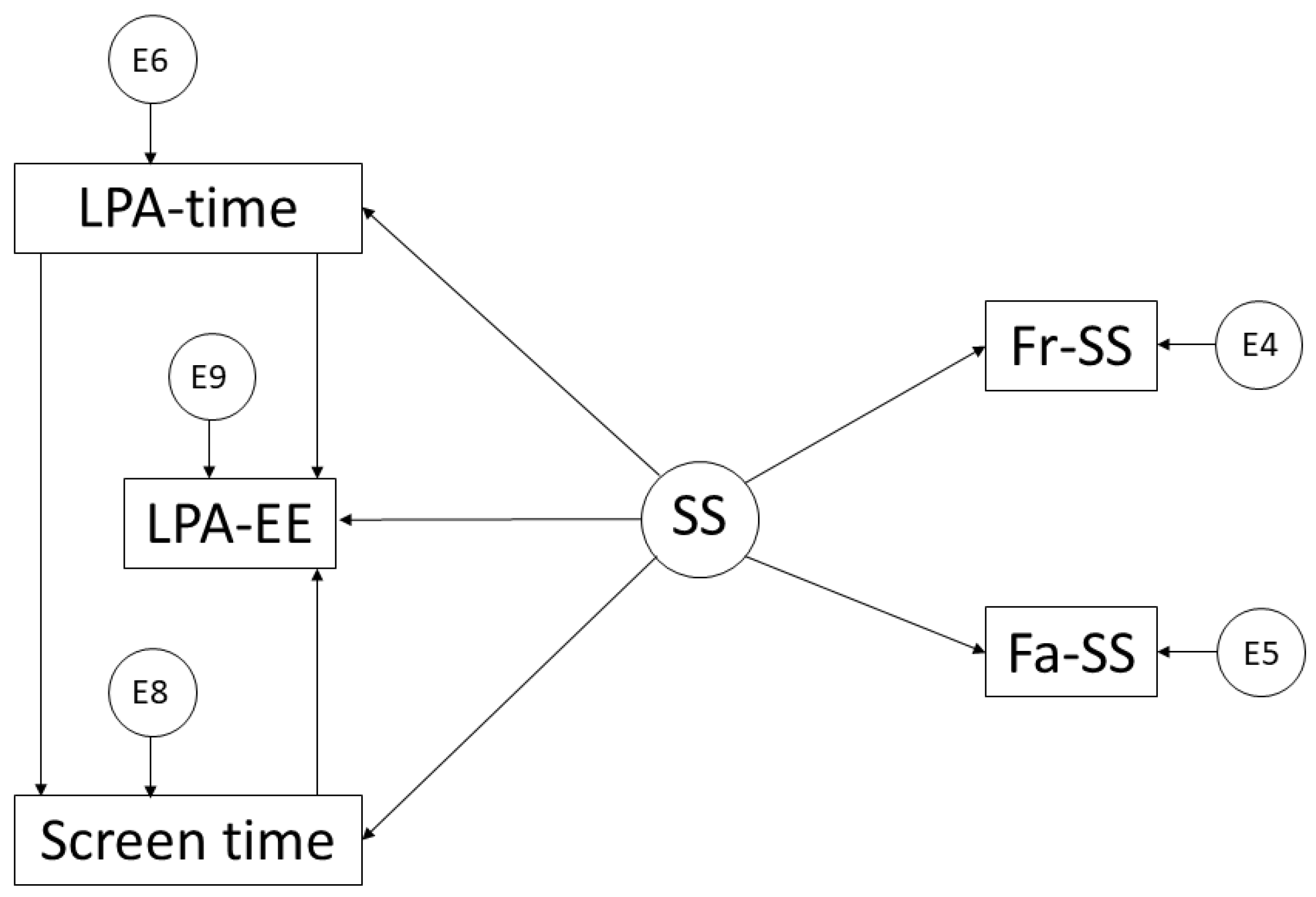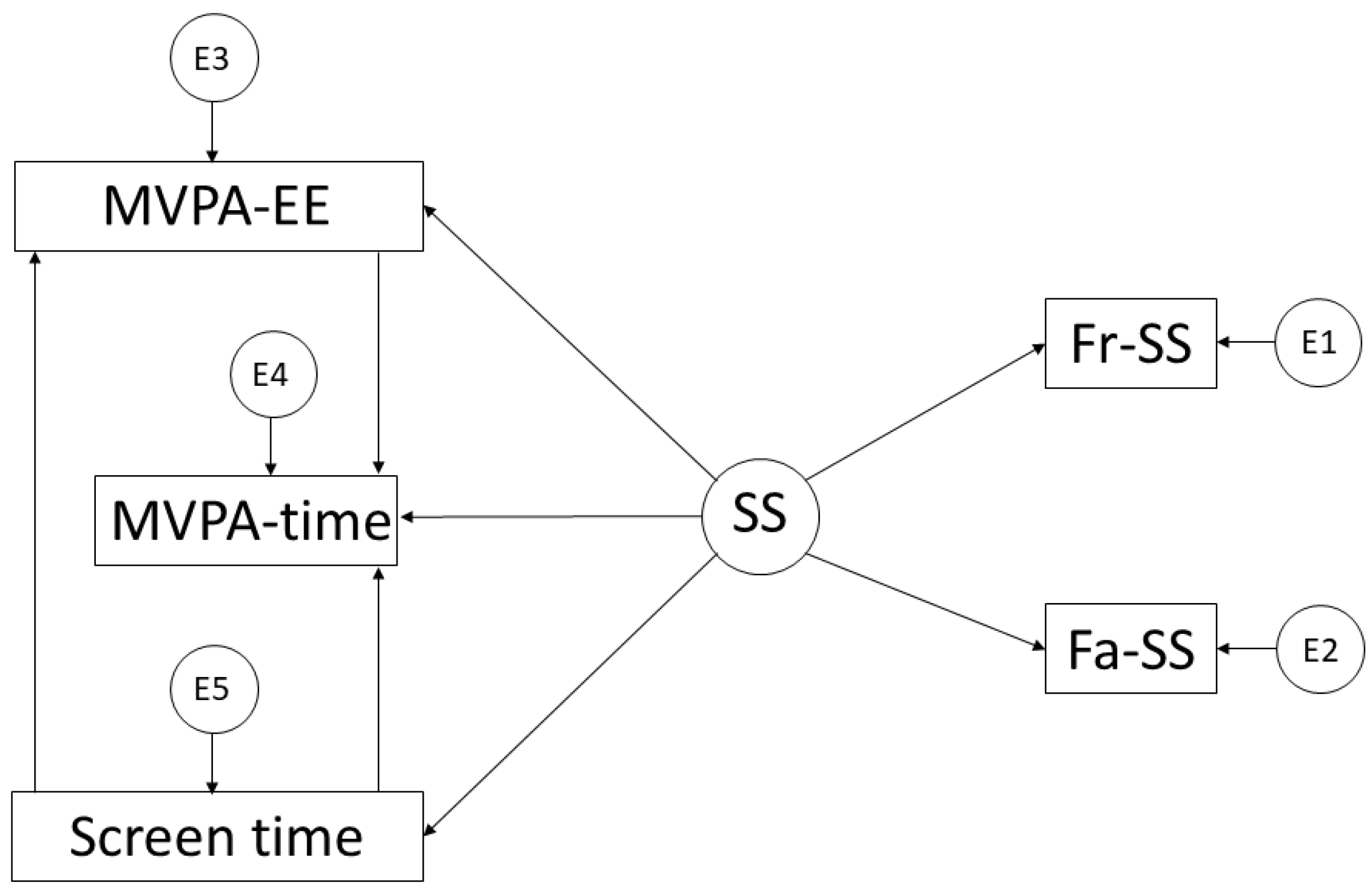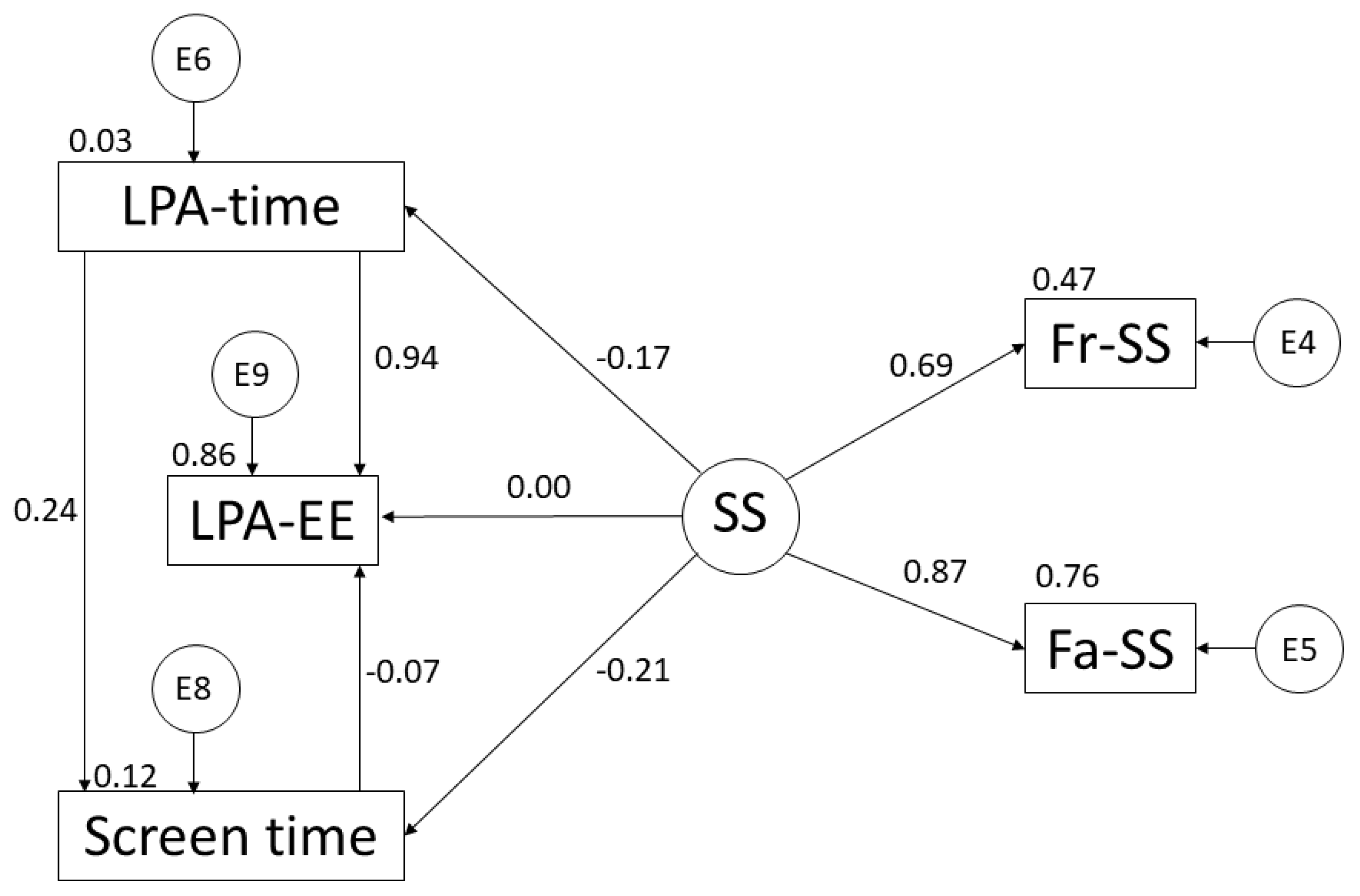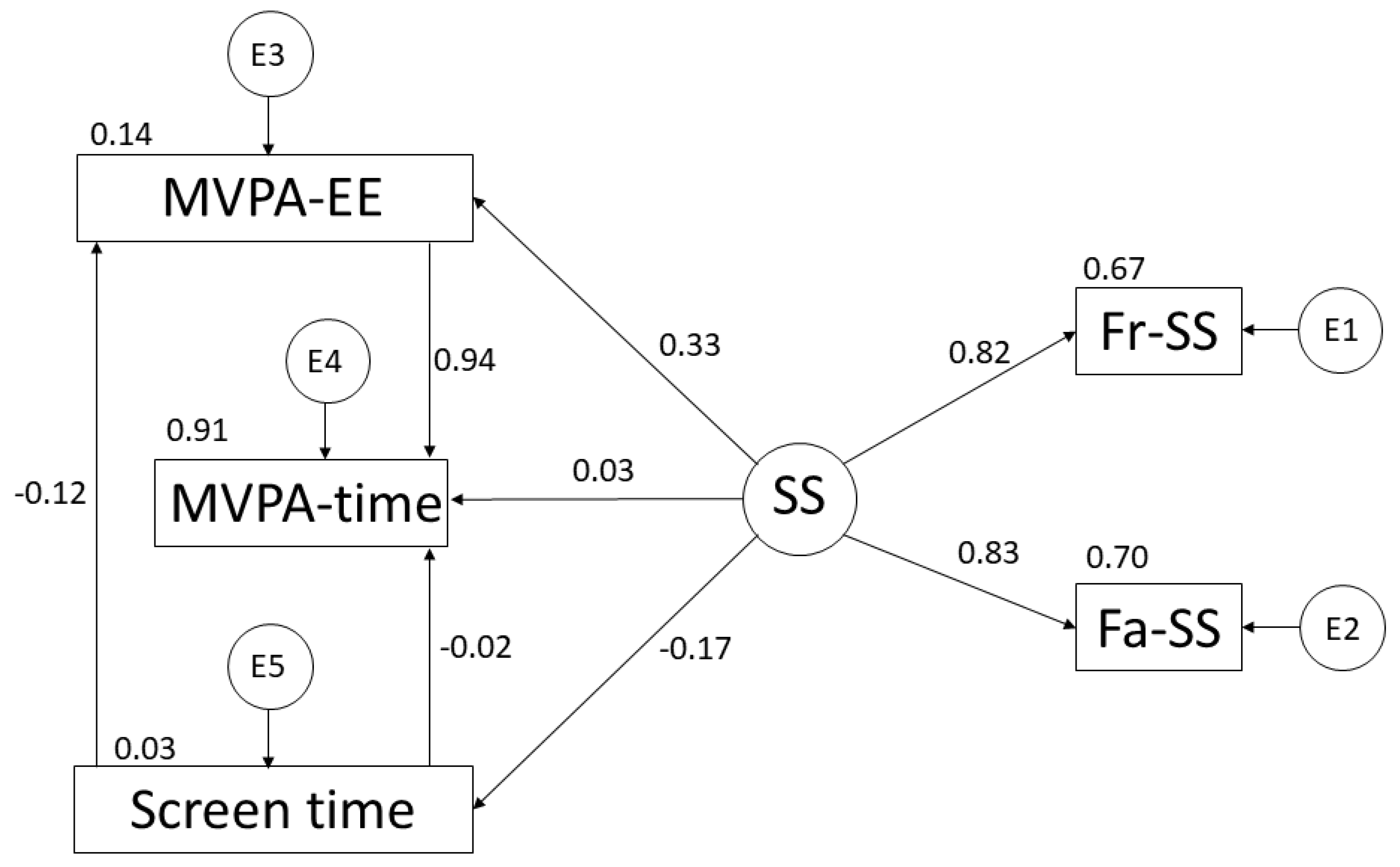Physical Activity, Energy Expenditure, Screen Time and Social Support in Spanish Adolescents—Towards an Explanatory Model about Health Risk Factors
Abstract
:1. Introduction
2. Materials and Methods
2.1. Design and Subjects
2.2. Instruments and Variables
2.3. Procedure
2.4. Data Analysis
3. Results
4. Discussion
5. Conclusions
Author Contributions
Funding
Institutional Review Board Statement
Informed Consent Statement
Data Availability Statement
Acknowledgments
Conflicts of Interest
References
- World Health Organization. Obesity and Overweight. Available online: https://www.who.int/es/news-room/fact-sheets/detail/obesity-and-overweight (accessed on 20 June 2022).
- Kumar, S.; Kelly, A.S. Review of Childhood Obesity: From Epidemiology, Etiology, and Comorbidities to Clinical Assessment and Treatment. Mayo Clin. Proc. 2017, 92, 251–265. [Google Scholar] [CrossRef] [PubMed]
- Aggarwal, B.; Jain, V. Obesity in Children: Definition, Etiology and Approach. Indian J. Pediatr. 2018, 85, 463–471. [Google Scholar] [CrossRef] [PubMed]
- Sanz-Martín, D.; Ruiz-Tendero, G.; Fernández-García, E. Relationship between the physical activity practice and the social support perceived in adolescents of the province of Soria. SPORT TK-Rev. EuroAmericana Cienc. Deporte 2020, 9, 67–74. [Google Scholar] [CrossRef]
- Chen, P.; Wang, D.; Shen, H.; Yu, L.; Gao, Q.; Mao, L.; Jiang, F.; Luo, Y.; Xie, M.; Zhang, Y.; et al. Physical activity and health in Chinese children and adolescents: Expert consensus statement (2020). Br. J. Sports Med. 2020, 54, 1321–1331. [Google Scholar] [CrossRef]
- Warburton, D.E.R.; Bredin, S.S.D. Health benefits of physical activity: A systematic review of current systematic reviews. Curr. Opin. Cardiol. 2017, 32, 541–556. [Google Scholar] [CrossRef] [PubMed]
- Rodriguez-Ayllon, M.; Cadenas-Sánchez, C.; Estévez-López, F.; Muñoz, N.E.; Mora-Gonzalez, J.; Migueles, J.H.; Molina-García, P.; Henriksson, H.; Mena-Molina, A.; Martínez-Vizcaíno, V.; et al. Role of Physical Activity and Sedentary Behavior in the Mental Health of Preschoolers, Children and Adolescents: A Systematic Review and Meta-Analysis. Sports Med. 2019, 49, 1383–1410. [Google Scholar] [CrossRef]
- Reiner, M.; Niermann, C.; Jekauc, D.; Woll, A. Long-term health benefits of physical activity–a systematic review of longitudinal studies. BMC Public Health 2013, 13, 813. [Google Scholar] [CrossRef]
- World Health Organization. Guidelines on Physical Activity and Sedentary Behaviour; World Health Organization: Geneva, Switzerland, 2020. [Google Scholar]
- Physical Activity Guidelines for Americans, 2nd ed.; U.S. Department of Health and Human Services: Washington, DC, USA, 2018. Available online: https://health.gov/sites/default/files/2019-09/Physical_Activity_Guidelines_2nd_edition.pdf (accessed on 10 July 2022).
- Friel, C.P.; Duran, A.T.; Shechter, A.; Diaz, K.M. U.S. Children Meeting Sleep, Screen Time, and Physical Activity Guidelines. Am. J. Prev. Med. 2020, 59, 513–521. [Google Scholar] [CrossRef]
- Guthold, R.; Stevens, G.A.; Riley, L.M.; Bull, F.C. Global trends in insufficient physical activity among adolescents: A pooled analysis of 298 population-based surveys with 1.6 million participants. Lancet Child Adolesc. Health 2020, 4, 23–35. [Google Scholar] [CrossRef]
- Steene-Johannessen, J.; Herman, B.; Eirik, K.; Kolle, E.; Northstone, K.; Christian, N.; Grøntved, A.; Wedderkopp, N.; Kriemler, S.; Page, A.S.; et al. Variations in accelerometry measured physical activity and sedentary time across Europe–harmonized analyses of 47,497 children and adolescents. Int. J. Behav. Nutr. Phys. Act. 2020, 17, 38. [Google Scholar] [CrossRef]
- Farooq, A.; Martin, A.; Janssen, X.; Wilson, M.G.; Gibson, A.M.; Hughes, A.; Reilly, J.J. Longitudinal changes in moderate-to-vigorous-intensity physical activity in children and adolescents: A systematic review and meta-analysis. Obes. Rev. 2020, 21, e12953. [Google Scholar] [CrossRef] [PubMed]
- Wilke, J.; Mohr, L.; Tenforde, A.S.; Edouard, P.; Fossati, C.; González-Gross, M.; Sánchez, C.; Laiño, F.; Tan, B.; David, J.; et al. A Pandemic within the Pandemic? Physical Activity Levels Substantially Decreased in Countries Affected by COVID-19. Int. J. Environ. Res. Public Health 2021, 18, 2235. [Google Scholar] [CrossRef] [PubMed]
- Chaffee, B.W.; Cheng, J.; Couch, E.T.; Hoeft, K.S.; Halpern-Felsher, B. Adolescents’ Substance Use and Physical Activity Before and During the COVID-19 Pandemic. JAMA Pediatr. 2021, 175, 715–722. [Google Scholar] [CrossRef]
- Chastin, S.F.M.; De Craemer, M.; De Cocker, K.; Powell, L.; Van Cauwenberg, J.; Dall, P.; Hamer, M.; Stamatakis, E. How does light-intensity physical activity associate with adult cardiometabolic health and mortality? Systematic review with meta-analysis of experimental and observational studies. Br. J. Sports Med. 2019, 53, 370–376. [Google Scholar] [CrossRef] [PubMed]
- Sallis, J.F.; Prochaska, J.J.; Taylor, W.C. A review of correlates of physical activity of children and adolescents. Med. Sci. Sports Exerc. 2000, 32, 963–975. [Google Scholar] [CrossRef]
- Gill, M.; Chan-Golston, A.M.; Rice, L.N.; Roth, S.E.; Crespi, C.M.; Cole, B.L.; Koniak-Griffin, D.; Prelip, M.L. Correlates of Social Support and its Association with Physical Activity Among Young Adolescents. Health Educ. Behav. 2018, 45, 207–216. [Google Scholar] [CrossRef]
- Lizandra, J.; Devís-Devís, J.; Valencia-Peris, A.; Tomás, J.M.; Peiró-Velert, C. Screen time and moderate-to-vigorous physical activity changes and displacement in adolescence: A prospective cohort study. Eur. J. Sport Sci. 2019, 19, 686–695. [Google Scholar] [CrossRef]
- National Library of Medicine. Medline Plus. Medical Encyclopedia. Screen Time and Children. Available online: https://medlineplus.gov/ency/patientinstructions/000355.htm (accessed on 20 June 2022).
- Moraleda-Cibrián, M.; Albares-Tendero, J.; Pin-Arboledas, G. Screen media use and sleep patterns in Spanish adolescents during the lockdown of the coronavirus pandemic. Sleep Breath. 2022, 15, 1–8. [Google Scholar] [CrossRef]
- Schmidt, S.C.E.; Anedda, B.; Burchartz, A.; Eichsteller, A.; Kolb, S.; Nigg, C.; Niessner, C.; Oriwol, D.; Worth, A.; Woll, A. Physical activity and screen time of children and adolescents before and during the COVID-19 lockdown in Germany: A natural experiment. Sci. Rep. 2020, 10, 21780. [Google Scholar] [CrossRef]
- O’Brien, W.; Issartel, J.; Belton, S. Relationship between Physical Activity, Screen Time and Weight Status among Young Adolescents. Sports 2018, 6, 57. [Google Scholar] [CrossRef]
- Zhu, Z.; Tang, Y.; Zhuang, J.; Liu, Y.; Wu, X.; Cai, Y.; Wang, L.; Cao, Z.B.; Chen, P. Physical activity, screen viewing time, and overweight/obesity among Chinese children and adolescents: An update from the 2017 physical activity and fitness in China—the youth study. BMC Public Health 2019, 19, 197. [Google Scholar] [CrossRef] [PubMed]
- Bejarano, C.M.; Carlson, J.A.; Conway, T.L.; Saelens, B.E.; Glanz, K.; Couch, S.C.; Cain, K.L.; Sallis, J.F. Physical Activity, Sedentary Time, and Diet as Mediators of the Association Between TV Time and BMI in Youth. Am. J. Health Promot. 2021, 35, 613–623. [Google Scholar] [CrossRef] [PubMed]
- Braig, S.; Genuneit, J.; Walter, V.; Brandt, S.; Wabitsch, M.; Goldbeck, L.; Brenner, H.; Rothenbacher, D. Screen Time, Physical Activity and Self-Esteem in Children: The Ulm Birth Cohort Study. Int. J. Environ. Res. Public Health 2018, 15, 1275. [Google Scholar] [CrossRef] [PubMed]
- Mendonça, G.; Cheng, L.A.; Mélo, E.N.; de Farias Júnior, J.C. Physical activity and social support in adolescents: A systematic review. Health Educ. Res. 2014, 29, 822–839. [Google Scholar] [CrossRef] [PubMed]
- Khan, S.R.; Uddin, R.; Mandic, S.; Khan, A. Parental and Peer Support are Associated with Physical Activity in Adolescents: Evidence from 74 Countries. Int. J. Environ. Res. Public Health 2020, 17, 4435. [Google Scholar] [CrossRef]
- O’Brien, W.; Coppinger, T.; Hogan, I.; Belton, S.; Murphy, M.H.; Powell, C.; Woods, C. The Association of Family, Friends, and Teacher Support with Girls’ Sport and Physical Activity on the Island of Ireland. J. Phys. Act. Health 2021, 18, 929–936. [Google Scholar] [CrossRef]
- Lisboa, T.; Silva, W.R.D.; Silva, D.A.S.; Felden, É.P.G.; Pelegrini, A.; Lopes, J.J.D.; Beltrame, T.S. Social support from family and friends for physical activity in adolescence: Analysis with structural equation modeling. Cad. Saude Publica 2021, 37, e00196819. [Google Scholar] [CrossRef]
- Robbins, L.B.; Ling, J.; Chang, M.W. Organized Physical Activity Program Participation, Physical Activity, and Related Psychosocial Factors Among Urban Adolescents. J. Sch. Nurs. 2021, 23, 10598405211038962. [Google Scholar] [CrossRef]
- Delgado, M.; Tercedor, P. Estrategias de Intervención en Educación Para la Salud Desde la Educación Física; INDE: Barcelona, Spain, 2002. [Google Scholar]
- Mason, J.O.; Powell, K.E. Physical activity, behavioral epidemiology, and public health. Public Health Rep. 1985, 100, 113–115. [Google Scholar]
- Dishman, R.K.; Heath, G.W.; Lee, I. Physical Activity Epidemiology; Human Kinetics: Champaign, IL, USA, 2013. [Google Scholar]
- Cale, L. Monitoring Physical Activity in children. Ph.D. Dissertation, Loughborough University, Leicestershire, UK, 1993. [Google Scholar]
- Cantera, M.A. Niveles de Actividad Física en la Adolescencia. Estudio Realizado en la Población Escolar de la Provincia de Teruel. Ph.D. Dissertation, University of Zaragoza, Huesca, Spain, 1997. [Google Scholar]
- Soler, J.J.; Generelo, E.; Zaragoza, J.; Julián, J.A. Validity and Reliability Criteria for the “Four by One-Day Physical Activity Questionnaire” in Spanish Adolescents. Apunts. Phys. Educ. Sports 2010, 101, 19–24. [Google Scholar]
- Peiró-Velert, C.; Devís-Devís, J.; Beltrán-Carrillo, V.J.; Fox, K.R. Variability of Spanish adolescent’s physical activity patterns by seasonality, day of the week and demographic factors. Eur. J. Sport Sci. 2008, 8, 163–171. [Google Scholar] [CrossRef]
- Peiró-Velert, C.; Valenciano, J.; Beltrán-Carrillo, V.; Devís-Devís, J. Variability of physical activity in 17–18 year-old Spanish adolescents by type of day and season. J. Sport Psychol. 2014, 23, 347–354. [Google Scholar]
- Viana, M.M.; Salguero, A.; Márquez, S.; Carpio-Rivera, E.; De Andrade, A.; De Bortoli, R.; Molinero, O. Influence of physical activity levels on the self-esteem of female students. Motricidade 2017, 13, 94–100. [Google Scholar]
- Prochaska, J.J.; Rodgers, M.W.; Sallis, J.F. Association of parent and peer support with adolescent physical activity. Res. Q Exerc Sport. 2002, 73, 206–210. [Google Scholar] [CrossRef] [PubMed]
- Sanz-Martín, D. Relationship between Physical Activity in Children and Perceived Support: A Case Studies. Apunts. Phys. Educ. Sports 2020, 139, 19–26. [Google Scholar] [CrossRef]
- Lubans, D.R.; Sylva, K.; Morgan, P.J. Factors associated with physical activity in a sample of British secondary school students. Aust. J. Educ. Dev. Psychol. 2007, 7, 22–30. [Google Scholar]
- Maydeu-Olivares, A. Assessing the Size of Model Misfit in Structural Equation Models. Psychometrika 2017, 82, 533–558. [Google Scholar] [CrossRef]
- McDonald, R.P.; Marsh, H.W. Choosing a multivariate model: Noncentrality and goodness of ft. Psychol. Bull. 1990, 107, 247–255. [Google Scholar] [CrossRef]
- Bentler, P.M. Comparative ft indexes in structural models. Psychol. Bull. 1990, 107, 238–246. [Google Scholar] [CrossRef]
- Kline, R.B. Principles and Practice of Structural Equation Modeling, 4th ed.; The Guilford Press: New York, NY, USA, 2016. [Google Scholar]
- Tenenbaum, G.; Eklund, R.C. Handbook of Sport Psychology; John Wiley and Sons: Hoboken, NJ, USA, 2007. [Google Scholar]
- Kinoshita, K.; Ozato, N.; Yamaguchi, T.; Sudo, M.; Yamashiro, Y.; Mori, K.; Ishida, M.; Katsuragi, Y.; Sasai, H.; Yasukawa, T.; et al. Association of sedentary behaviour and physical activity with cardiometabolic health in Japanese adults. Sci. Rep. 2022, 12, 2262. [Google Scholar] [CrossRef]
- Prince, S.A.; Elliott, C.G.; Scott, K.; Visintini, S.; Reed, J.L. Device-measured physical activity, sedentary behaviour and cardiometabolic health and fitness across occupational groups: A systematic review and meta-analysis. Int. J. Behav. Nutr. Phys. Act. 2019, 16, 30. [Google Scholar] [CrossRef]
- Lawman, H.G.; Wilson, D.K. Associations of social and environmental supports with sedentary behavior, light and moderate-to-vigorous physical activity in obese underserved adolescents. Int. J. Behav. Nutr. Phys. Act. 2014, 11, 92. [Google Scholar] [CrossRef]
- Huffman, L.E.; Wilson, D.K.; Van Horn, M.L.; Pate, R.R. Associations Between Parenting Factors, Motivation, and Physical Activity in Overweight African American Adolescents. Ann. Behav. Med. 2018, 52, 93–105. [Google Scholar] [CrossRef]
- Wang, X.; Hui, Z.; Terry, P.D.; Ma, M.; Cheng, L.; Deng, F.; Gu, W.; Zhang, B. Correlates of Insufficient Physical Activity among Junior High School Students: A Cross-Sectional Study in Xi’an, China. Int. J. Environ. Res. Public Health 2016, 13, 397. [Google Scholar] [CrossRef]
- Engels, E.S.; Nigg, C.R.; Reimers, A.K. Predictors of physical activity behavior change based on the current stage of change—An analysis of young people from Hawai’i. J. Behav. Med. 2022, 45, 38–49. [Google Scholar] [CrossRef]
- Pluta, B.; Korcz, A.; Krzysztoszek, J.; Bronikowski, M.; Bronikowska, M. Associations between adolescents’ physical activity behavior and their perceptions of parental, peer and teacher support. Arch. Public Health 2020, 78, 106. [Google Scholar] [CrossRef]
- Doggui, R.; Gallant, F.; Bélanger, M. Parental control and support for physical activity predict adolescents’ moderate to vigorous physical activity over five years. Int. J. Behav. Nutr. Phys. Act. 2021, 18, 43. [Google Scholar] [CrossRef]
- Park, S.H.; Park, H. Parental Support and Children’s Body Weight: Mediating Effects of Health Behaviors. West J. Nurs. Res. 2020, 42, 718–727. [Google Scholar] [CrossRef]
- Costigan, S.A.; Barnett, S.; Plotnikoff, R.C.; Lubans, D.R. The Health Indicators Associated with Screen-Based Sedentary Behavior Among Adolescent Girls: A Systematic Review. J. Adolesc. Health 2013, 52, 382–392. [Google Scholar] [CrossRef]
- Haidar, A.; Ranjit, N.; Archer, N.; Hoelscher, D.M. Parental and peer social support is associated with healthier physical activity behaviors in adolescents: A cross-sectional analysis of Texas School Physical Activity and Nutrition (TX SPAN) data. BMC Public Health 2019, 19, 640. [Google Scholar] [CrossRef]
- Ren, Y.; Li, M. Influence of physical exercise on social anxiety of left-behind children in rural areas in China: The mediator and moderator role of perceived social support. J. Affect. Disord. 2020, 266, 223–229. [Google Scholar] [CrossRef]
- McVeigh, J.; Meiring, R. Physical activity and sedentary behavior in an ethnically diverse group of South African school children. J. Sports Sci. Med. 2014, 13, 371–378. [Google Scholar]




| Associations between Variables | R.W. | S.R.W. | |||
|---|---|---|---|---|---|
| Estimations | S.E. | C.R. | p | Estimations | |
| LPA Time ← SS | −29.216 | 10.383 | −2.814 | ** | −0.167 |
| ST ← SS | −41.615 | 11.592 | −3.590 | *** | −0.210 |
| ST ← LPA time | 0.272 | 0.058 | 4.722 | *** | 0.239 |
| Fr-SS ← SS | 1.000 | 0.686 | |||
| Fa-SS ← SS | 1.732 | 0.405 | 4.282 | *** | 0.871 |
| LPA-EE ← SS | 0.005 | 0.125 | 0.040 | 0.968 | 0.001 |
| LPA-EE ← LPA time | 0.029 | 0.001 | 45.854 | *** | 0.944 |
| LPA-EE ← ST | −0.002 | 0.001 | −3.172 | ** | −0.067 |
| Associations between Variables | R.W. | S.R.W. | |||
|---|---|---|---|---|---|
| Estimations | S.E. | C.R. | p | Estimations | |
| MVPA-time ← SS | 2.611 | 1.633 | 1.598 | 0.110 | 0.033 |
| ST ← SS | −22.871 | 8.179 | −2.796 | ** | −0.173 |
| MVPA-time ← ST | −0.009 | 0.010 | −0.893 | 0.372 | −0.015 |
| Fr-SS ← SS | 1.000 | 0.818 | |||
| Fa-SS ← SS | 1.369 | 0.193 | 7.097 | *** | 0.834 |
| MVPA-EE ← SS | 2.115 | 0.408 | 5.183 | *** | 0.328 |
| MVPA-time ← MVPA-EE | 11.656 | 0.227 | 51.444 | *** | 0.938 |
| MVPA-EE ← ST | −0.006 | 0.003 | −2.273 | ** | −0.120 |
Publisher’s Note: MDPI stays neutral with regard to jurisdictional claims in published maps and institutional affiliations. |
© 2022 by the authors. Licensee MDPI, Basel, Switzerland. This article is an open access article distributed under the terms and conditions of the Creative Commons Attribution (CC BY) license (https://creativecommons.org/licenses/by/4.0/).
Share and Cite
Sanz-Martín, D.; Melguizo-Ibáñez, E.; Ruiz-Tendero, G.; Zurita-Ortega, F.; Ubago-Jiménez, J.L. Physical Activity, Energy Expenditure, Screen Time and Social Support in Spanish Adolescents—Towards an Explanatory Model about Health Risk Factors. Int. J. Environ. Res. Public Health 2022, 19, 10222. https://doi.org/10.3390/ijerph191610222
Sanz-Martín D, Melguizo-Ibáñez E, Ruiz-Tendero G, Zurita-Ortega F, Ubago-Jiménez JL. Physical Activity, Energy Expenditure, Screen Time and Social Support in Spanish Adolescents—Towards an Explanatory Model about Health Risk Factors. International Journal of Environmental Research and Public Health. 2022; 19(16):10222. https://doi.org/10.3390/ijerph191610222
Chicago/Turabian StyleSanz-Martín, Daniel, Eduardo Melguizo-Ibáñez, Germán Ruiz-Tendero, Félix Zurita-Ortega, and José Luis Ubago-Jiménez. 2022. "Physical Activity, Energy Expenditure, Screen Time and Social Support in Spanish Adolescents—Towards an Explanatory Model about Health Risk Factors" International Journal of Environmental Research and Public Health 19, no. 16: 10222. https://doi.org/10.3390/ijerph191610222
APA StyleSanz-Martín, D., Melguizo-Ibáñez, E., Ruiz-Tendero, G., Zurita-Ortega, F., & Ubago-Jiménez, J. L. (2022). Physical Activity, Energy Expenditure, Screen Time and Social Support in Spanish Adolescents—Towards an Explanatory Model about Health Risk Factors. International Journal of Environmental Research and Public Health, 19(16), 10222. https://doi.org/10.3390/ijerph191610222








